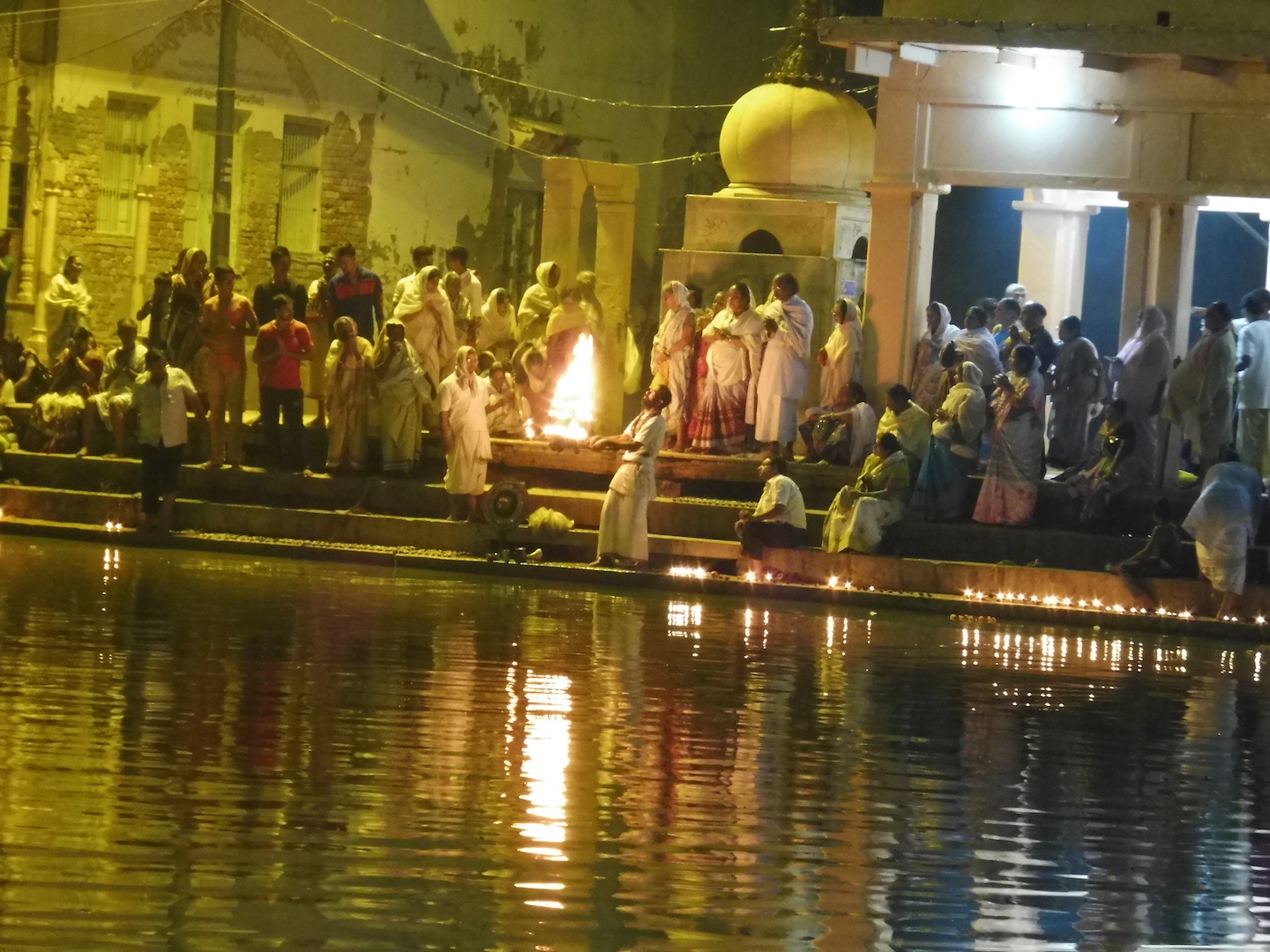Happy Deepavali and Govardhan Puja
DIWALI FESTIVAL: 10th October. 1968,
(Letter from Srila Prabhupada to Hamsadutta dasa written from Seattle., Letters book Vol 1. p.549.)Diwali ceremony can be observed in the temple by illuminating 100’s of candles, indifferent parts of the temple, and offering a special Prasad to the Deity. This ceremony was observed by the inhabitants of Ayodhya, the Kingdom of Lord Ramachandra, while Lord Ramachandra was out of His Kingdom due to His 14 years banishment by the order of His father. His younger step-brother Bharat, took charge of the Kingdom and the day on which Lord Ramachandra took back the charge again from His brother, and seated on the throne, this is observed as Diwali, and Deepabali. Deepabali means the same thing – Deepa means candles, and bali means numerous. When numerous candles are lighted it is called Deepabali. In India, this Deepavali function is celebrated in a special auspicious occassion. This Deepabali function can be observed on 21st October, and Prasad can be distributed on 22nd October, during daytime, which is known as Govardhan Puja and Annakuta Ceremony. In India, in all Vaishnava temples, this ceremony is observed and 100’s of people are given prasadam according to the capacity of the temple.
So I understand that last year the Deepabali ceremony was held in the temple, and there was collection of $130.00. So you can do the needful. Hope you are all well.
Your Ever Well Wisher.
A.C.Bhaktivedanta Swami
————————-
Diwali
The story goes that Hanuman was sent by Rama to Ayodhya the day before Rama’s arrival as prearranged with Bharat to let the residents of Ayodhya know how Sita and Rama and all Their retinue were returning.
This was five days before Diwali, and after the Vijaya dasami (victory of Rama ) celebration.
THE STORY BEHIND “DIWALI” King Dashrath ruled the rich and prosperous city of Ayodhya. He had three wives and Kaikayi was his favourite. She saved his life in a war at a very crucial time. Dashrath granted her two favours for saving his life.
Dashrath had four sons. Rama, the oldest, was everybody’s favourite. He was married to the beautiful and devoted Sita. Just before Ram’s coromation, Kaikayi reminded Dashrath of her two favors. She told him to crown Bharat as king and to banish Ram to the jungle for fourteen years. Her wishes were granted.
The old king Dashrath later died of a broken heart. After a few years in the forest, Sita was lured by the demon king Ravana. Rama, with the help of a monkey general, Hanuman, rescued Sita and defeated Ravana. After fourteen years in exile Ram and Sita and returned to Ayodhya.
It is in Their honor that “Diwali” is celebrated. “Diwali” signifies the victory of good over evil.
Today in India for Diwali all the shops are decorated brightly. Many people make “rangoli” in their house or outside. They are filled to capacity in this festive season. Everybody buys new things and decorates their homes. People visit their friends and relatives and give them sweets. On Diwali friends come over for the whole day and relatives come and go. Everyone has a wonderful time celebrating the return of Sita and Rama. Thus Diwali has become a day when all the sad things of the past are forgotten and happy times are remembered.
Srila Prabhupada explains the actual meaning of Dipavali celebration
of Lord Krsna breaking the pot of yogurt and being bound by Yasodamayi
Srī-śuka uvāca
ekadā gṛha-dāsīṣu
yaśodā nanda-gehinīkarmāntara-niyuktāsu
nirmamantha svayaṁ dadhiyāni yānīha gītāni
tad-bāla-caritāni ca
dadhi-nirmanthane kāle
smarantī tāny agāyataSYNONYMSśrī-śukaḥ uvāca—Śrī Śukadeva Gosvāmī said; ekadā—one day; gṛha-dāsīṣu—when all the maidservants of the household were otherwise engaged; yaśodā—mother Yaśodā; nanda-gehinī—the queen of Nanda Mahārāja; karma-antara—in other household affairs; niyuktāsu—being engaged; nirmamantha—churned; svayam—personally; dadhi—the yogurt; yāni—all such; yāni—such; iha—in this connection; gītāni—songs; tat-bāla-caritāni—in which the activities of her own child were enacted; ca—and; dadhi-nirmanthane—while churning the yogurt; kāle—at that time; smarantī—remembering; tāni—all of them (in the form of songs); agāyata—chanted.
TRANSLATIONŚrī Śukadeva Gosvāmī continued: One day when mother Yaśodā saw that all the maidservants were engaged in other household affairs, she personally began to churn the yogurt. While churning, she remembered the childish activities of Kṛṣṇa, and in her own way she composed songs and enjoyed singing to herself about all those activities.
PURPORTŚrīla Viśvanātha Cakravartī Ṭhākura, quoting from the Vaiṣṇava-toṣaṇī of Śrīla Sanātana Gosvāmī, says that the incident of Kṛṣṇa’s breaking the pot of yogurt and being bound by mother Yaśodā took place on the Dipavali Day, or Dīpa-mālikā. Even today in India, this festival is generally celebrated very gorgeously in the month of Kārtika by fireworks and lights, especially in Bombay. It is to be understood that among all the cows of Nanda Mahārāja, several of mother Yaśodā’s cows ate only grasses so flavorful that the grasses would automatically flavor the milk. Mother Yaśodā wanted to collect the milk from these cows, make it into yogurt and churn it into butter personally, since she thought that this child Kṛṣṇa was going to the houses of neighborhood gopas and gopīs to steal butter because He did not like the milk and yogurt ordinarily prepared.While churning the butter, mother Yaśodā was singing about the childhood activities of Kṛṣṇa. It was formerly a custom that if one wanted to remember something constantly, he would transform it into poetry or have this done by a professional poet. It appears that mother Yaśodā did not want to forget Kṛṣṇa’s activities at any time. Therefore she poeticized all of Kṛṣṇa’s childhood activities, such as the killing of Pūtanā, Aghāsura, Śakaṭāsura and Tṛṇāvarta, and while churning the butter, she sang about these activities in poetical form. This should be the practice of persons eager to remain Kṛṣṇa conscious twenty-four hours a day. This incident shows how Kṛṣṇa conscious mother Yaśodā was. To stay in Kṛṣṇa consciousness, we should follow such persons.
(Srimad-Bhagavatam 10.9.1-2)








Speak Your Mind